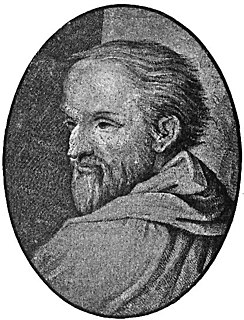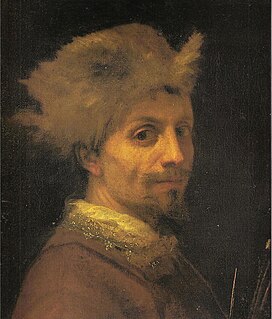Marco Chierice (born 1580) was an Italian painter.
Marco Chierice (born 1580) was an Italian painter.
He was born and trained in Correggio. He mainly painted still-lives and landscapes. He painted in the parish church of Mandriolo (frazione of Correggio), and for the destroyed Casino of Count Ottavio Bolognesi. He was a painter for Duke Ferdinand Charles of Mantua. [1]

Agostino Carracci was an Italian painter, printmaker, tapestry designer, and art teacher. He was, together with his brother, Annibale Carracci, and cousin, Ludovico Carracci, one of the founders of the Accademia degli Incamminati in Bologna. This teaching academy promoted the Carracci emphasized drawing from life. It promoted progressive tendencies in art and was a reaction to the Mannerist distortion of anatomy and space. The academy helped propel painters of the School of Bologna to prominence.

Antonio Allegri da Correggio, usually known as just Correggio, was the foremost painter of the Parma school of the High Italian Renaissance, who was responsible for some of the most vigorous and sensuous works of the sixteenth century. In his use of dynamic composition, illusionistic perspective and dramatic foreshortening, Correggio prefigured the Baroque art of the seventeenth century and the Rococo art of the eighteenth century. He is considered a master of chiaroscuro.

Lodovico Cardi, also known as Cigoli, was an Italian painter and architect of the late Mannerist and early Baroque period, trained and active in his early career in Florence, and spending the last nine years of his life in Rome.

Illusionistic ceiling painting, which includes the techniques of perspective di sotto in sù and quadratura, is the tradition in Renaissance, Baroque and Rococo art in which trompe-l'œil, perspective tools such as foreshortening, and other spatial effects are used to create the illusion of three-dimensional space on an otherwise two-dimensional or mostly flat ceiling surface above the viewer. It is frequently used to create the illusion of an open sky, such as with the oculus in Andrea Mantegna's Camera degli Sposi, or the illusion of an architectural space such as the cupola, one of Andrea Pozzo's frescoes in Sant'Ignazio, Rome. Illusionistic ceiling painting belongs to the general class of illusionism in art, designed to create accurate representations of reality.

Giovanni Maria Francesco Rondani was an Italian painter, active in a Renaissance style in Parma.

Francesco Trevisani was an Italian painter, active in the period called either early Rococo or late Baroque (barochetto).

Carlo Giuseppe Ratti (1737–1795) was an Italian art biographer and painter of the late-Baroque period. He was a pupil of the painter Giovanni Agostino Ratti. Born in Savona, he moved to Rome where he befriended Anton Raphael Mengs and Pompeo Batoni. He died in Genoa, where he labored for many years.

Girolamo Donnini was an Italian painter of the Baroque period, born in the town of Correggio, Emilia-Romagna. He was a pupil of the painters Francesco Stringa in Modena, and then of Giovanni Gioseffo dal Sole in Bologna, then traveled to Forlì to work with Carlo Cignani.

Giuseppe Pedretti was an Italian painter of the late-Baroque or Rococo period, active mainly in Bologna.

Bartolomeo Guidobono (1654–1709) was an Italian painter known for his scenes with angelic looking figures bathing in soft lighting, which show the influence of Correggio. His elegant and graceful style was very popular in Genoa. He is also known as il Prete di Savona or Prete Bartolomeo da Savona.
Antonio Bruno was an Italian painter of the Renaissance period. He was born in Modena or Correggio, and painted at Parma in the manner of Correggio, of whom, if not a pupil, he was a great imitator and contemporary, as one of his works is dated 1530. He painted a Madonna and Saints for the parish church in Santi Senesio e Teopompo, Castelvetro di Modena.
Antonio Bernieri (1516–1565) was an Italian painter of the Renaissance period. He was born in Correggio. He was first trained under Correggio; on the death of that master he went to Venice, and attended Titian's school. He visited Rome, and returning to Venice worked there until 1563. He died at Correggio. Bernieri was an eminent painter of portrait miniatures. He is sometimes called 'Antonio da Correggio’, which unfortunately confuses him with his mentor.

Giulio or Giuliano Traballesi or Trabellesi (1727–1812) was an Italian designer and engraver.
Antonio Dardani (1677–1735) was an Italian painter of the Baroque period, mainly in his native Bologna..

Antonio Begarelli, also known as Begarino (1499–1565) was an Italian sculptor.
Carlo Mazza (1704-1777) was an Italian painter.
Giuseppe Orazio Capretti was an Italian painter.
Giovanni Giarola or Gerolli (1518–1557) was an Italian painter of the Renaissance style, active mainly in Reggio Emilia.

Leda and the Swan is an oil on canvas painting from 1530–31 by the Italian painter Correggio, now in the Gemäldegalerie in Berlin. It shows three scenes of Leda's seduction by Jupiter who has taken the form of a swan. Their first meeting is shown on the right hand side and their lovemaking in the centre, where Leda sits with the swan between her thighs, guiding him with her left hand. They are accompanied to their left by Cupid with his bow and two cupids with flutes. The third scene is the swan flying away whilst Leda gets dressed. Leda and the Swan was a common subject in 16th-century art.

The Mantegna funerary chapel is one of the chapels of the Basilica of Sant'Andrea, Mantua. It houses the tomb of the painter Mantegna and his last two paintings - Baptism of Christ and Holy Family with St John the Baptist, St Elizabeth and St Zacharias (1504-1506). Its frescoes from 1507 were painted by his sons Ludovico and Francesco and by a young Correggio. The tomb bears a bronze figure of Mantegna by Gianmarco Cavalli.